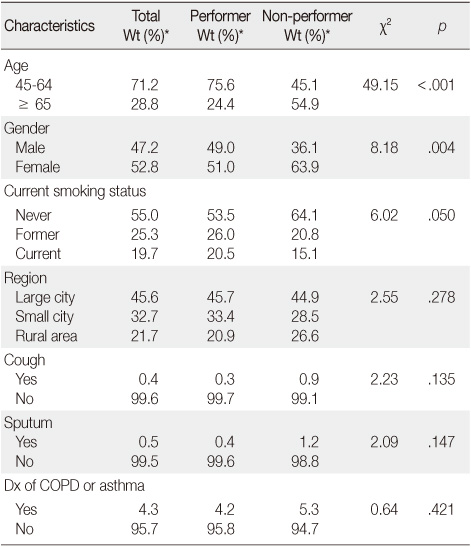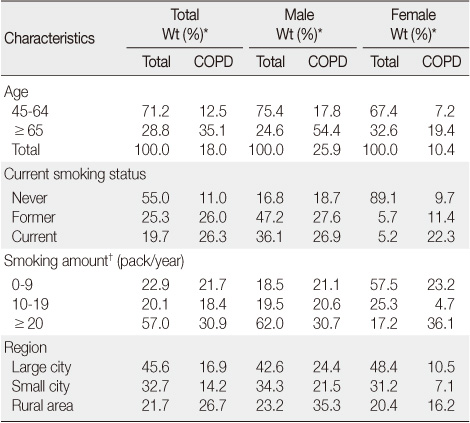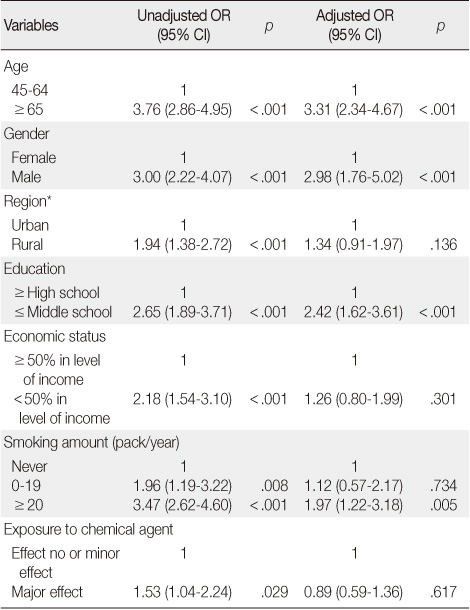Articles
- Page Path
- HOME > J Korean Acad Nurs > Volume 41(2); 2011 > Article
-
Original Article
- Chronic Obstructive Pulmonary Disease in Korea: Prevalence, Risk Factors, and Quality of Life
- Young-Mi Jung, Heeyoung Lee
-
Journal of Korean Academy of Nursing 2011;41(2):149-156.
DOI: https://doi.org/10.4040/jkan.2011.41.2.149
Published online: April 30, 2011
1Associate Professor, Department of Nursing, Daegu Haany University, Daegu, Korea.
2Assistant Professor, School of Nursing, University of Pittsburgh, Pittsburgh, Pennsylvania, USA.
- Address reprint requests to: Lee, Heeyoung. School of Nursing, University of Pittsburgh, 415 Victoria Building, 3500 Victoria Street, Pittsburgh, PA 15261, USA. Tel: +1-412-624-5073, +1-206-369-6719, Fax: +1-412-383-7293, leehee@pitt.edu
© 2011 Korean Society of Nursing Science
Abstract
-
Purpose
- This study seeks to examine prevalence, risk factors, and quality of life of Korean adults with Chronic Obstructive Pulmonary Disease (COPD).
-
Methods
- From the database of the Fourth Korean National Health and Nutrition Examination Survey (KNHANES IV-1, 2008), the researchers selected 1,458 adults over the age of 45. The original study was a population-based epidemiological survey of health and nutrition with a stratified multistage clustered probability design. Prevalence of COPD was computed on the basis of the sampling weight. Data were analyzed using descriptive statistics, χ2 test, t-test and multiple logistic regression with the SPSS WIN 18.0 and SAS Ver. 9.1 program.
-
Results
- The prevalence of COPD was 18.0% among people older than 45 yr. The prevalence of current smokers was 19.7% in this population and 26.3% in individuals with COPD. Age, gender, education, and smoking levels were found to be risk factors for COPD. Significant difference in quality of life was founded between adults with COPD and the healthy controls.
-
Conclusion
- The results of this study indicate that COPD is a highly prevalent disease in Korea. To reduce the prevalence of COPD and improve health-related quality of life in patients with COPD, nursing interventions must focus on prevention of risk factors.
- 1. Anzueto A. Clinical course of chronic obstructive pulmonary disease: Review of therapeutic interventions. The American Journal of Medicine. 2006;119:10 Suppl 1. 46–53.ArticlePubMed
- 2. Chan-Yeung M, Ait-Khaled N, White N, Ip MS, Tan WC. The burden and impact of COPD in Asia and Africa. The International Journal of Tuberculosis and Lung Disease. 2004;8(1):2–14.PubMed
- 3. Chung HG, Song JS. 2008 National health insurance statistical year book. 2009;Seoul, National Health Insurance Statistical Corporation, Health Insurance Review & Assessment Service.
- 4. Creutzberg EC. Factors associated with prognosis in COPD: Influencing of body composition and systemic corticosteroid use on morbidity and mortality. Chronic Respiratory Disease. 2004;1:79–81.PubMed
- 5. Danielsson T, Rossner S, Westin A. Open randomised trial of intermittent very low energy diet together with nicotine gum for stopping smoking in women who gained weight in previous attempts to quit. British Medical Journal. 1999;319:490–493.PMC
- 6. Eisner MD, Balmes J, Katz BP, Trupin L, Yelin E, Blanc P. Lifetime environmental tobacco smoke exposure and the risk of chronic obstructive pulmonary disease. Environmental Health. 2005;4(1):7. PubMedPMC
- 7. EuroQol Group. EuroQol: A new facility for the measurement of health-related quality of life. Health Policy. 1990;16:199–208.ArticlePubMed
- 8. Global Chronic Obstructive Lung Disease [GOLD] data. Global Initiative for Chronic Obstructive Lung Disease. 2009;01 01 Retrieved , November 1, 2009. from http://www.goldcopd.com/download.asp?in-tId=552.
- 9. Hegewald MJ, Crapo RO. Socioeconomic status and lung function. Chest. 2007;132:1608–1614.ArticlePubMed
- 10. Hnizdo E, Sullivan PA, Bang KM, Wagner G. Airflow obstruction attributable to work in industry and occupation among U.S. race/ethnic groups: A study of NHANES III data. American Journal of Industrial Medicine. 2004;46:126–135.ArticlePubMed
- 11. Kang GJ. Symptom experiences, self-care, and quality of life in COPD patients. 2007;Pusan, Pusan National University. Unpublished master's thesis.
- 12. Kim DS, Kim YS, Jung JS, Chang JH, Lim CM, Lew WJ, et al. Prevalence of chronic obstructive pulmonary disease in Korea: A population-based spirometry survey. American Journal of Respiratory and Critical Care Medicine. 2005;172:842–847.PubMed
- 13. Korea National Statistical Office. Census of elderly population in Korean 2009 year. 2009;10;Seoul, Author.
- 14. Lamprecht B, Schirnhofer L, Kaiser B, Studnicka M, Buist AS. Farming and the prevalence of non-reversible airways obstruction: Results from a population-based study. American Journal of Industrial Medicine. 2007;50:421–426.ArticlePubMed
- 15. Langhammer A, Johnsen R, Holmen J, Gulsvik A, Bjermer L. Cigarette smoking gives more respiratory symptoms among women than among men. The Nord-Trondelag Health Study (HUNT). Journal of Epidemiology and Community Health. 2000;54:917–922.ArticlePubMedPMC
- 16. Leidy NK, Haase JE. Functional performance in people with chronic obstructive pulmonary disease: A qualitative analysis. Advances in Nursing Science. 1996;18(3):77–89.ArticlePubMed
- 17. Mannino DM, Homa DM, Akinbami LJ, Ford ES, Redd SC. Chronic obstructive pulmonary disease surveillance: United States, 1971-2000. Morbidity and Mortality Weekly Report. Surveillance Summaries. 2002;51(SS06):1–16.
- 18. Nam HS, Kwon SS, Ko KO, Paul K. EQ-5D Korean valuation study using time trade off method. 2007;Seoul, Korea Centers for Disease Control and Prevention.
- 19. National Cardiovascular, Lung, and Blood Diseases data. National Heart, Lung, and Blood Institute. 2009;01 01 Retrieved , June 22, 2010. from http://www.nhlbi.nih.gov/resources/docs/2009_ChartBook.pdf.
- 20. Nazir SA, Erbland ML. Chronic obstructive pulmonary disease: An update on diagnosis and management issues in older adults. Drugs & Aging. 2009;26:813–831.Article
- 21. Oh EG, Kim SH, Kim BH, Park MS, Kim SK, Kim YS. Health behavior and quality of life in Korean adults with respiratory disease: National Health Survey, 2005. The International Journal of Tuberculosis and Lung Disease. 2010;14:772–778.PubMed
- 22. Oh YM. Clinical year in review of COPD for pulmonary physicians. Tuberculosis and Respiratory Diseases. 2008;64:409–413.Article
- 23. Schane RE, Woodruff PG, Dinno A. Prevalence and risk factors for depressive symptoms in persons with chronic obstructive pulmonary disease. Journal of General Internal Medicine. 2008;23:1757–1762.ArticlePubMedPMCPDF
- 24. Seong SS, Choi CB, Sung YK, Park YW, Lee HS, Uhm WS, et al. Health-related quality of life using EQ-5D in Koreans. The Journal of the Korean Rheumatism Association. 2004;11:254–262.
- 25. Song TM, Choi JH. The effect of on-line smoking cessation program. Health and Social Welfare Review. 2006;26(2):37–67.
- 26. Stavem K, Lossius MI, Kvien TK, Guldvog B. The health-related quality of life of patients with epilepsy compared with angina pectoris, rheumatoid arthritis, asthma, and chronic obstructive pulmonary disease. Quality of Life Research. 2000;9:865–871.ArticlePubMedPDF
- 27. The Fourth Korea National Health and Nutrition Examination Survey [KNHANES IV-1] data. Korea Centers for Disease Control and Prevention. 2008;12 01 Retrieved October 26, 2009. from http://knhanes.cdc.go.kr/.
- 28. The Fourth Korea National Health and Nutrition Examination Survey [KNHANES IV-2] data. Korea Centers for Disease Control and Prevention. 2010;01 01 Retrieved February 15, 2010. from http://knhanes.cdc.go.kr/.
- 29. Viegi G, Pedreschi M, Pistelli F, Di Pede F, Baldacci S, Carrozzi L, et al. Prevalence of airways obstruction in a general population: European Respiratory Society versus American Thoracic Society definition. Chest. 2000;117:339S–345S.ArticlePubMed
- 30. Wang Q, Bourbeau J. Outcomes and health-related quality of life following hospitalization for an acute exacerbation of COPD. Respirology. 2005;10:334–340.ArticlePubMed
REFERENCES
Figure & Data
REFERENCES
Citations

- Prevalence and Risk Factors of Restrictive Pulmonary Disease in Korean Older Adults
Do-Youn Lee
Journal of The Korean Society of Physical Medicine.2025; 20(1): 99. CrossRef - COPD Prevalence and Risk Factors in Korean Older Adults
Do-Youn Lee
The Journal of Korean Physical Therapy.2025; 37(1): 31. CrossRef - Analysis of Risk Factors for COPD Incidence in Adults Over 40 Years of Age in Korea
Do-Youn Lee
Journal of The Korean Society of Physical Medicine.2024; 19(1): 23. CrossRef - Mediating Effect of Self-Efficacy on the Relationship between Symptom Experience and Health-Related Quality of Life in Patients with Chronic Obstructive Pulmonary Disease
Enhee Jo, Ju-Young Park, Young Jun Jang
Journal of Korean Academy of Fundamentals of Nursing.2024; 31(3): 315. CrossRef - Inhibitory Effects of GGX on Lung Injury of Chronic Obstructive Lung Disease (COPD) Mice Model
Tae Hyeon Kim, Won Kyung Yang, Su Won Lee, Seung Hyung Kim, Yee Ran Lyu, Yang Chun Park
Journal of Korean Medicine.2021; 42(3): 56. CrossRef - Qualitative Analysis of the Disease Experience of Korean Older Men With Chronic Obstructive Pulmonary Disease
Kisook Kim, Ji Woon Ko, Sangbong Choi
Journal of Gerontological Nursing.2020; 46(2): 49. CrossRef - Novel nomogram based on risk factors of chronic obstructive pulmonary disease (COPD) using a naïve Bayesian classifier model
Ju-Hyun Seo, Jea-Young Lee
Journal of the Korean Statistical Society.2019; 48(2): 278. CrossRef - Factors influencing on health-related quality of life in South Korean with chronic liver disease
Hyun Jin Kim, Hyeonsik Chu, Seonhye Lee
Health and Quality of Life Outcomes.2018;[Epub] CrossRef - Effects of Gwaruhaengryeon-hwan on COPD and Particulate Matter Induced Lung Injury on a Mouse Model
Chul-wha Lee, Won-kyung Yang, Yee-ran Lyu, Seung-hyeong Kim, Yang-chun Park
The Journal of Internal Korean Medicine.2017; 38(3): 353. CrossRef - Effect of the trunk forward bending angle in sitting position on slow vital capacity
Juncheol Lee, Dongwook Han
Journal of Physical Therapy Science.2017; 29(12): 2220. CrossRef - Quality of life and its related factors in patients with Korean chronic obstructive pulmonary disease
So Youn Bang
Journal of the Korean Data and Information Science Society.2016; 27(5): 1349. CrossRef - Incapacity, Handicap, and Oxidative Stress Markers of Male Smokers With and Without COPD
Syrine Ben Moussa, Sonia Rouatbi, Helmi Ben Saad
Respiratory Care.2016; 61(5): 668. CrossRef - Gender Differences in Health‐Related Quality of Life of Korean Patients with Chronic Obstructive Lung Disease
Jisu Kim, Kisook Kim
Public Health Nursing.2015; 32(3): 191. CrossRef - Effects of Sagan-tang and individual herbs on COPD Mice Model
Jong-Min Han, Won-Kyung Yang, Seung-Hyeong Kim, Yang-Chun Park
Herbal Formula Science.2015; 23(2): 171. CrossRef - Effects of Smoking Status on Chronic Obstructive Pulmonary Disease Prevalence in Males 40 years and Older: Findings from the Korean National Health and Nutrition Examination Survey
In Sook Jung, In-Kyung Jung
Korean Journal of Health Promotion.2014; 14(4): 155. CrossRef - Factors affecting health status in patients with chronic obstructive pulmonary disease
Ayse Cil Akinci, Erkan Yildirim
International Journal of Nursing Practice.2013; 19(1): 31. CrossRef - Fatigue, anxiety and depression levels, activities of daily living of patients with chronic obstructive pulmonary disease
Papatya Karakurt, Ayla Ünsal
International Journal of Nursing Practice.2013; 19(2): 221. CrossRef - Gender differences of health behaviors and quality of life of Koreans with asthma
Yeonsoo Jang, Hyera Yoo
Open Journal of Nursing.2013; 03(06): 420. CrossRef - The Development of Infants from Low-Income Families, Parenting Characteristics, and Daily Routines
Hanna Kang, Hyewon Park
Family and Environment Research.2013; 51(6): 613. CrossRef - Effects of Consumer-Centered u-Health Service for the Knowledge, Skill, and Attitude of the Patients With Chronic Obstructive Pulmonary Disease
JEONGEUN KIM, SUKWHA KIM, HEE-CHAN KIM, KYUNG-HWAN KIM, SEOK-CHUL YANG, CHOON-TAEK LEE, HYOUN-JOONG KONG, KYUNGSOON LEE
CIN: Computers, Informatics, Nursing.2012; 30(12): 661. CrossRef - Relationship of Knowledge, Attitude, Correct Metered Dose Inhaler Use, and Self-management Compliance among Patients with COPD
Min-Hee An, Ja-Yun Choi
Korean Journal of Adult Nursing.2012; 24(2): 160. CrossRef - Quality of Life in the Urban Adults by Age
Jung Sook Choi, EunHee Lee, AeYoung So, Kyung-Sook Lee
Journal of muscle and joint health.2012; 19(3): 362. CrossRef
Comparison between Performers and Non-performers of Spirometry among Participants
*Weighted frequencies.
Dx=physician diagnosis; COPD=chronic obstructive pulmonary disease.
Prevalence of Chronic Obstruction Pulmonary Disease by GOLD Criteria
*Weighted frequencies; †Included former and current smokers.
GOLD criteria; FEV1/FVC ratio <70%; GOLD=global initiative for chronic obstructive lung disease.
Unadjusted Odds Ratios and Adjusted Odds Ratio for Chronic Obstructive Pulmonary Disease as Dependent Variable and Risk Factors as Independent Variables among Korean Adults over 45
*Region (Urban=large city+small city; rural).
OR=odds ratio; CI=confidence interval.
*Weighted frequencies. Dx=physician diagnosis; COPD=chronic obstructive pulmonary disease.
*Weighted frequencies; †Included former and current smokers. GOLD criteria; FEV1/FVC ratio <70%; GOLD=global initiative for chronic obstructive lung disease.
*Region (Urban=large city+small city; rural). OR=odds ratio; CI=confidence interval.
 KSNS
KSNS
 E-SUBMISSION
E-SUBMISSION



 Cite
Cite

